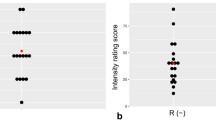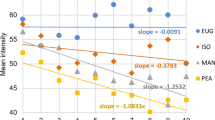Abstract
Sex differences in olfactory sensitivity have been reported since the late 1800’s with women typically outperforming men on tests of odor detection, discrimination or identification. It is not known whether women adapt differently than men to olfactory and trigeminal stimuli. Seventeen healthy volunteers participated (9 female, 8 male, mean age 22 years) in the study. As established by an odor identification test (UPSIT, score ≥38) all subjects had normal olfactory function. Event-related potentials (ERPs) were recorded in response to olfactory (25% v/v phenyl ethyl alcohol) and trigeminal (44% v/v CO2) stimuli using a computer controlled olfactometer (flow 8 L/min; stimulus duration 200 ms). Stimuli were applied at four intervals (5, 10, 20, and 60 s). Amplitudes and latencies of ERP peaks P1, N1, and P2 were measured. Stimulus intensity also rated using visual analogue scales subjects. When compared to phenyl ethyl alcohol, the slightly more intense CO2 produced larger amplitudes and shorter latencies. Both, ratings and ERP amplitudes P2 decreased with decreasing interval between stimuli. Responses to the trigeminal and olfactory stimuli changed similarly in relation to repetitive stimulation. Women had larger ERP amplitudes P2. No sex-related difference for ratings and ERP in relation to repeated stimulation amplitudes was observed. Although women exhibit larger ERP amplitudes to chemosensory stimuli compared to men, the present data indicate on both psychophysical and electrophysiological levels that there is no major difference between young, healthy men and women in relation to short-term adaptation to suprathreshold chemosensory stimulation.


Similar content being viewed by others
References
Bailey E, Powell E (1884) Preliminary notes on the delicacy of special senses. NY Med 40:325
Becker E, Hummel T, Piel E, Pauli E, Kobal G, Hautzinger M (1993) Olfactory event-related potentials in psychosis-prone subjects. Int J Psychol 15:51–58
Cain WS (1977) Bilateral interaction in olfaction. Nature 268:50–53. doi:10.1038/268050a0
Cain WS, Stevens JC, Nickou CM, Giles A, Johnston I, Garcia-Medina MR (1995) Life-span development of odor identification, learning, and olfactory sensitivity. Perception 24:1457–1472. doi:10.1068/p241457
Dalton P, Dilks D, Hummel T (2006) Effects of long-term exposure to volatile irritants on sensory thresholds, negative mucosal potentials, and event-related potentials. Behav Neurosci 120:180–187. doi:10.1037/0735-7044.120.1.180
Dalton P, Hummel T (2000) Chemosensory function and response in idiopathic environmental intolerance. Occup Med 15:539–556
Doty RL, Shaman P, Dann M (1984) Development of the University of Pennsylvania smell identification test: a standardized microencapsulated test of olfactory function. Physiol Behav 32:489–502. doi:10.1016/0031-9384(84)90269-5
Elsberg CS, Brewer ED, Levy I (1935) The sense of smell. IV. Concerning conditions which may temporarily alter normal olfactory acuity. Bull Neurol Inst NY 4:31–34
Hummel T, Gruber M, Pauli E, Kobal G (1994) Event-related potentials in response to repetitive painful stimulation. Electroencephalogr Clin Neurophysiol 92:426–432. doi:10.1016/0168-5597(94)90020-5
Hummel T, Knecht M, Kobal G (1996) Peripherally obtained electrophysiological responses to olfactory stimulation in man: electro-olfactograms exhibit a smaller degree of desensitization compared with subjective intensity estimates. Brain Res 717:160–164. doi:10.1016/0006-8993(96)00094-7
Hummel T, Kobal G (1999) Chemosensory event-related potentials to trigeminal stimuli change in relation to the interval between repetitive stimulation of the nasal mucosa. Eur Arch Otorhinolaryngol 256:16–21. doi:10.1007/s004050050115
Hummel T, Kobal G (2001) Olfactory event-related potentials. In: Simon SA, Nicolelis MAL (eds) Methods and frontiers in chemosensory research. CRC press, Boca Raton, pp 429–464
Hummel T, von Mering R, Huch R, Kolble N (2002) Olfactory modulation of nausea during early pregnancy? BJOG 109:1394–1397. doi:10.1046/j.1471-0528.2002.02287.x
Kobal G (1981) Elektrophysiologische Untersuchungen des menschlichen Geruchssinns. Thieme Verlag, Stuttgart
Kobal G, Klimek L, Wolfensberger M, Gudziol H, Temmel A, Owen CM, Seeber H, Pauli E, Hummel T (2000) Multicenter investigation of 1,036 subjects using a standardized method for the assessment of olfactory function combining tests of odor identification, odor discrimination, and olfactory thresholds. Eur Arch Otorhinolaryngol 257:205–211. doi:10.1007/s004050050223
Koelega HS, Köster EP (1974) Some experiments on sex differences in odor perception. Ann N Y Acad Sci 237:234–246. doi:10.1111/j.1749-6632.1974.tb49859.x
Köster EP (1965) Adaptation, recovery and specificity of olfactory receptors. Rev Laryngol Otol Rhinol (Bord) 86:880–894
Köster EP, de Wijk RA (1991) Olfactory adaptation. In: Laing DG, Doty RL, Breipohl W (eds) The human sense of smell. Springer, Berlin, pp 199–215
Lundstrom JN, Frasnelli J, Larsson M, Hummel T (2005) Sex differentiated responses to intranasal trigeminal stimuli. Int J Psychophysiol 57:181–186. doi:10.1016/j.ijpsycho.2005.01.003
Pierce JDJ, Wysocki CJ, Aronov EV, Webb JB, Boden RM (1996) The role of perceptual and structural similarity in cross-adaptation. Chem Senses 21:223–237. doi:10.1093/chemse/21.2.223
Poellinger A, Thomas R, Lio P, Lee A, Makris N, Rosen BR, Kwong KK (2001) Activation and habituation in olfaction—an fMRI study. Neuroimage 13:547–560. doi:10.1006/nimg.2000.0713
Schneider RA, Wolf S (1955) Olfactory perception thresholds for citral utilizing a new type olfactorium. J Appl Physiol 8:337–342
Soiffer A, Doty RL, Hummel T (1998) Lateralized vs. bilateral measurement of olfactory thresholds: comparison of two methods. Chem Senses 22:799
Stuck BA, Frey S, Freiburg C, Hörmann K, Zahnert T, Hummel T (2006) Chemosensory event-related potentials in relation to side of stimulation, age, sex, and stimulus concentration. Clin Neurophysiol 117:1367–1375. doi:10.1016/j.clinph.2006.03.004
Wysocki CJ, Gilbert AN (1989) National Geographic Smell Survey: effects of age are heterogenous. Ann N Y Acad Sci 561:12–28
Yousem DM, Maldjian J, Siddiqi F, Hummel T, Alsop D, Geckle RJ, Bilker WB, Doty RL (1998) Gender-effects on odor-stimulated functional magnetic resonance imaging. Brain Res 818:480–487. doi:10.1016/S0006-8993(98)01276-1
Acknowledgments
We would like to thank Richard L. Doty for helpful discussion during initiation of the study.
Author information
Authors and Affiliations
Corresponding author
Rights and permissions
About this article
Cite this article
Scheibe, M., Opatz, O. & Hummel, T. Are there sex-related differences in responses to repetitive olfactory/trigeminal stimuli?. Eur Arch Otorhinolaryngol 266, 1323–1326 (2009). https://doi.org/10.1007/s00405-008-0860-0
Received:
Accepted:
Published:
Issue Date:
DOI: https://doi.org/10.1007/s00405-008-0860-0




